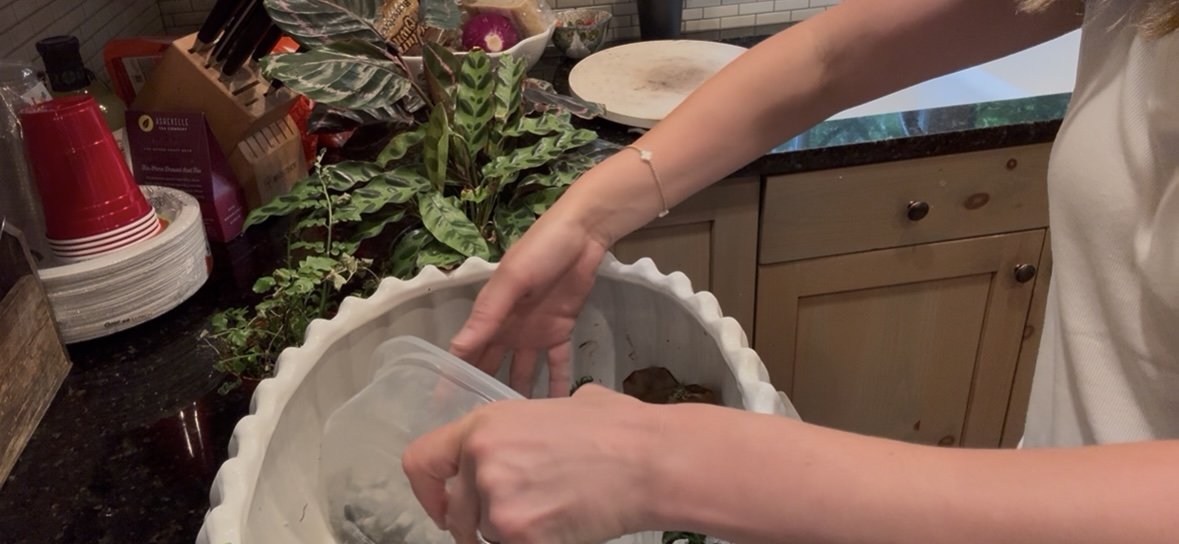The Indoor Planter Fix I Finally Figured Out
Those who know me know I’m a plant lover—but what I’m not is a plant expert. Still, if you ever want to give me a gift? A plant is always perfect in my book.
Last year, a dear friend gifted me a gorgeous planter full of orchids. It was such a treat! But, as much as I love orchids, I’m not patient or skilled enough to wait for them to rebloom. Once they died off, I decided to give the container new life by adding some fresh greenery. I headed to a plant shop, picked out a few pretty new plants, popped them in—and... it didn’t go quite as planned.
Soggy Paper & Sad Plants
I quickly realized that while the plants were lovely, the setup was all wrong. The paper in the bottom of the planter got soggy fast, the plants looked sad, and watering it weekly became a chore. I knew I couldn’t just fill it with dirt (roots need drainage or they rot), but I had never really looked into how to do a proper indoor planter—until now.
Enter: A Simple DIY from West Coast Gardens
I finally caved and did some research. I found this post from West Coast Gardens (highly recommend!) that broke things down in the simplest way. I followed Jason’s easy instructions and was amazed at how straightforward it was.
Here’s the gist:
1. Add rocks or gravel to the bottom of your container (I used some gravel my husband had leftover from a project behind the shed—don’t tell!).
2. Add a layer of horticultural charcoal (more on that below).
3. Fill with potting soil and plant away!
Now, instead of lugging this big planter to the sink each week, I just give the plants a spritz on Water Wednesdays—and they seem so much happier. And honestly? So am I.
Horticultural Charcoal: My New Favorite Plant Find
I had never even heard of horticultural charcoal before (plant lover, not expert—remember?). But wow, I’m a fan now. After doing a little research, I learned it helps prevent root rot by absorbing excess moisture and improving drainage—perfect for terrariums and indoor containers. I ordered a bag from Amazon and started adding it to a few of my pots where the plants were struggling. It’s really helped!
For example, here’s a ZZ plant I keep on my husband’s bedside table (he’s lucky to sleep next to a plant, don’t you think? 😉). This plant is famously easy to care for—my Plantopedia book by Lauren Camilleri and Sophia Kaplan even calls it the “unkillable plant.”
But I had a problem: I had transferred it from a draining pot into a cute, non-draining one, and the soil kept disappearing every time I overwatered and had to dump it out. Since adding a layer of charcoal, it’s been much more manageable. The soil stays put, and I just spritz it weekly along with my other plants.
My mother-in-law gifted me Plantopedia by Lauren Camilleri and Sophia Kaplan for my birthday, and I love it! It’s been fun to look up all the plants I already have around the house and learn more about how to care for them. This would make a perfect gift for any plant-loving friend! You can find it here on Amazon.
So Glad I Finally Looked Into This
I have quite a few indoor planters that have just been holding plastic nursery pots—because I didn't know how to pot them properly. But now that I’ve learned how to create real drainage inside non-draining containers, I’m slowly replanting a few each week. No more dragging heavy pots to the sink!
Let’s Swap Tips!
Do you have any indoor plant tips or tricks? Please share them in the comments—I’d love to learn from you! I’m still figuring things out as I go, but I love having these green little companions around my home.
Happy watering,
Reeves
PS: I also recently got one of those Easy Plants you may have seen on Instagram—I'll share how it's going soon!
Note: This post contains Amazon affiliate links, which means I may earn a small commission if you make a purchase—at no extra cost to you. I only share products I truly love and use in my own home.










